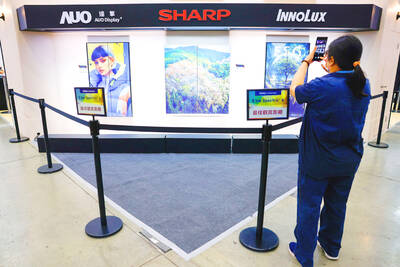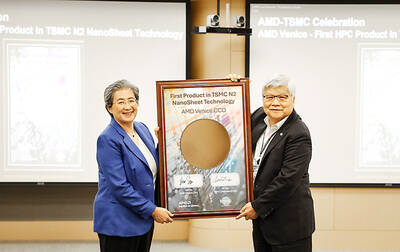The nation’s two biggest LCD panel makers, AU Optronics Corp (AUO, 友達) and Innolux Corp (群創), on Wednesday reported that their second-quarter net profits were the strongest quarterly figures in more than seven years, benefiting from the industry’s longest boom cycle amid a supply crunch.
The companies expressed confidence about the third quarter, despite recent price corrections.
The prolonged boom has boosted prices of flat panels and TVs, which only sidelined consumer purchasing and dampened TV sales briefly, the firms said.
Recent price reductions are to serve as a catalyst for robust TV sales during the peak season, which begins this quarter, AUO and Innolux executives said.
“Customers are building inventories for the high season,” AUO chairman and chief executive officer Paul Peng (彭双浪) told an investors’ teleconference. “We believe business is coming back after brief turbulence.”
“The third quarter should be a strong season. TV vendors are stepping up sales promotions to reach whole-year sales targets and taking advantage of recent price adjustments,” Peng said.
Growth drivers are mainly to come from cathode ray tube TV replacement demand in emerging markets, including Asia, Latin America and Russia, AUO said.
AUO said it is not worried about a potential risk of oversupply, with several new Chinese plants to begin mass production later this year.
“Based on our calculations, additional supply from China will only add 3 percent capacity to the market, which is not sufficient to tilt the supply-demand balance,” Peng said.
This year is to be a healthy one for the LCD industry, as global panel demand is expected to outgrow supply by about 2 percent, AUO said.
Meanwhile, Innolux downplayed potential effects from China, where the world’s first 10.5G fab is to begin mass production next year.
“We do not expect oversupply to happen in all segments next year, despite overall supply growth expected to be significant,” Innolux chairman Wang Jyh-chao (王志超) said at a separate teleconference.
“Chinese panel makers might only produce mid to low-end panels using that new, advanced factory due to high technological barriers,” Wang said.
The firms might be immune to the effects, as they focus on making high-end panels for TVs with narrow bezels and rich color performance, they said.
In the quarter ended June 30, AUO’s net profit rose 3.7 percent to NT$9.83 billion (US$324.94 million), compared with NT$9.48 billion in the first quarter, which was a nine-year high.
Shipments of TV and PC panels are expected to be flat, or rise slightly, this quarter from last quarter, AUO said.
Average selling prices are expected to be little changed on a quarterly basis, it said.
TV panel shipments are expected to rise by a low single-digit percentage this quarter, while average selling price is expected to fall by a low single-digit percentage, Innolux said.
Innolux’s net profit last quarter rose to a seven-year high of NT$12.12 billion, up 2.2 percent from NT$11.86 billion in the first quarter.

Taiwan will prioritize the development of silicon photonics by taking advantage of its strength in the semiconductor industry to build another shield to protect the local economy, National Development Council (NDC) Minister Paul Liu (劉鏡清) said yesterday. Speaking at a meeting of the legislature’s Economics Committee, Liu said Taiwan already has the artificial intelligence (AI) industry as a shield, after the semiconductor industry, to safeguard the country, and is looking at new unique fields to build more economic shields. While Taiwan will further strengthen its existing shields, over the longer term, the country is determined to focus on such potential segments as

UNCERTAINTY: Innolux activated a stringent supply chain management mechanism, as it did during the COVID-19 pandemic, to ensure optimal inventory levels for customers Flat-panel display makers AUO Corp (友達) and Innolux Corp (群創) yesterday said that about 12 to 20 percent of their display business is at risk of potential US tariffs and that they would relocate production or shipment destinations to mitigate the levies’ effects. US tariffs would have a direct impact of US$200 million on AUO’s revenue, company chairman Paul Peng (彭雙浪) told reporters on the sidelines of the Touch Taiwan trade show in Taipei yesterday. That would make up about 12 percent of the company’s overall revenue. To cope with the tariff uncertainty, AUO plans to allocate its production to manufacturing facilities in

COLLABORATION: Given Taiwan’s key position in global supply chains, the US firm is discussing strategies with local partners and clients to deal with global uncertainties Advanced Micro Devices Inc (AMD) yesterday said it is meeting with local ecosystem partners, including Taiwan Semiconductor Manufacturing Co (TSMC, 台積電), to discuss strategies, including long-term manufacturing, to navigate uncertainties such as US tariffs, as Taiwan occupies an important position in global supply chains. AMD chief executive officer Lisa Su (蘇姿丰) told reporters that Taiwan is an important part of the chip designer’s ecosystem and she is discussing with partners and customers in Taiwan to forge strong collaborations on different areas during this critical period. AMD has just become the first artificial-intelligence (AI) server chip customer of TSMC to utilize its advanced

Chizuko Kimura has become the first female sushi chef in the world to win a Michelin star, fulfilling a promise she made to her dying husband to continue his legacy. The 54-year-old Japanese chef regained the Michelin star her late husband, Shunei Kimura, won three years ago for their Sushi Shunei restaurant in Paris. For Shunei Kimura, the star was a dream come true. However, the joy was short-lived. He died from cancer just three months later in June 2022. He was 65. The following year, the restaurant in the heart of Montmartre lost its star rating. Chizuko Kimura insisted that the new star is still down